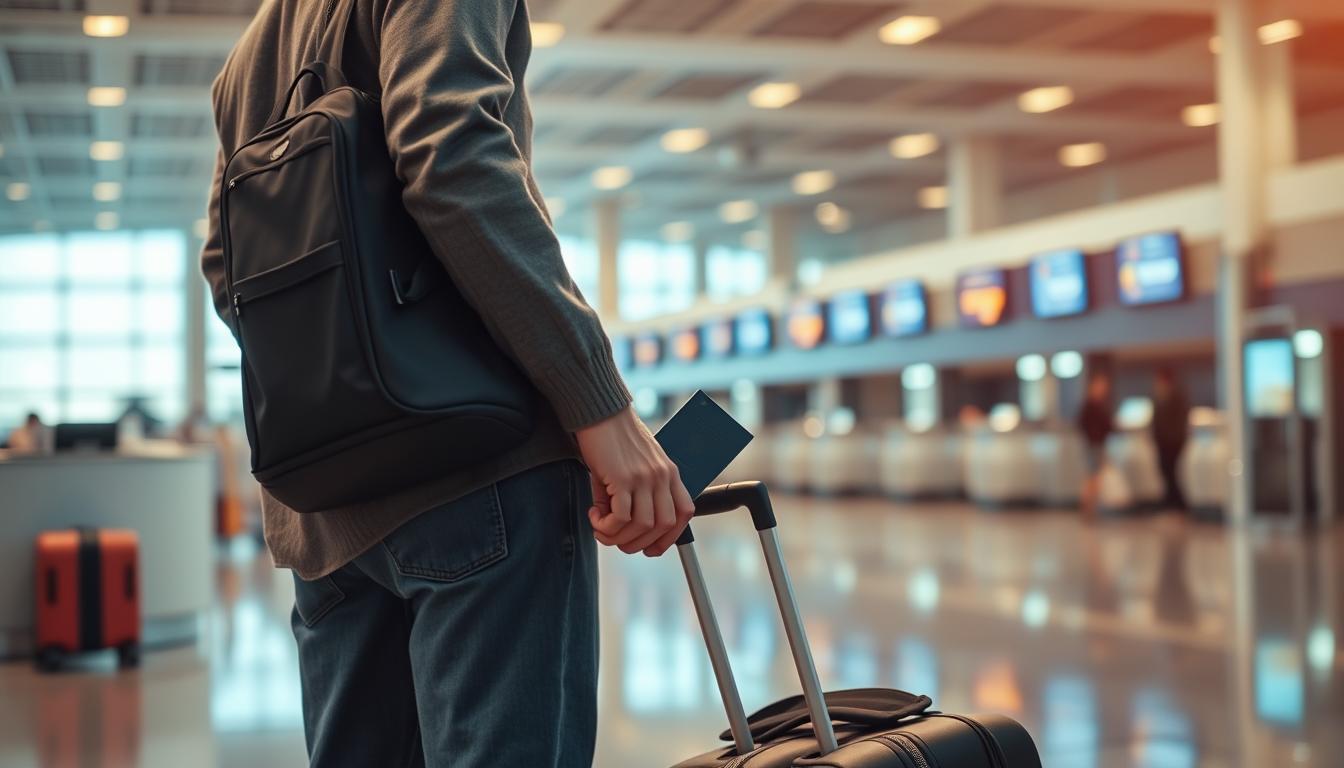How to Survive Long Flights: The Ultimate Guide for Comfortable Travel
As someone who’s logged countless hours in the sky, I’ve compiled this comprehensive guide to help you not just endure but actually enjoy your next long flight. From pre-flight preparation to recovery tips after landing, these expert strategies will help you arrive at your destination feeling refreshed and ready for adventure.
Before Your Flight: Setting Yourself Up for Success
Choose the Right Seat
Your seat selection can make or break your long-haul experience. Window seats offer a place to lean and sleep without being disturbed, while aisle seats provide easy access to stretch your legs and visit the restroom. Middle seats should be avoided unless you’re traveling with companions.
For the best seat options, check SeatGuru.com before booking. This invaluable resource provides detailed aircraft seating charts with passenger reviews highlighting the best and worst seats on your specific flight.
“The seasoned travelers, after takeoff, you go down the cabin and you can see that they’re gone – they’ve covered themselves up and they’re asleep.”
Book the Right Flight Time
If possible, book early morning flights. They typically experience fewer delays and align better with your body’s natural rhythm. For overnight flights, try to match your destination’s time zone by sleeping when it would be nighttime at your arrival location.
Red-eye flights can be advantageous if you can sleep on planes, as you’ll maximize your daytime hours at your destination. However, if you struggle to sleep while flying, a daytime flight might be preferable.
Plan Your Meals Strategically
If maximizing sleep is your priority on an overnight flight, consider eating before boarding. This strategy is particularly effective for flights in the 5-8 hour range where sleep time is limited.
For longer flights, you’ll likely be offered multiple meals. Don’t feel obligated to eat whenever food is served if it doesn’t align with your sleep schedule or hunger levels. Listen to your body and eat when it makes sense for your travel plan.
Essential Items to Pack in Your Carry-On
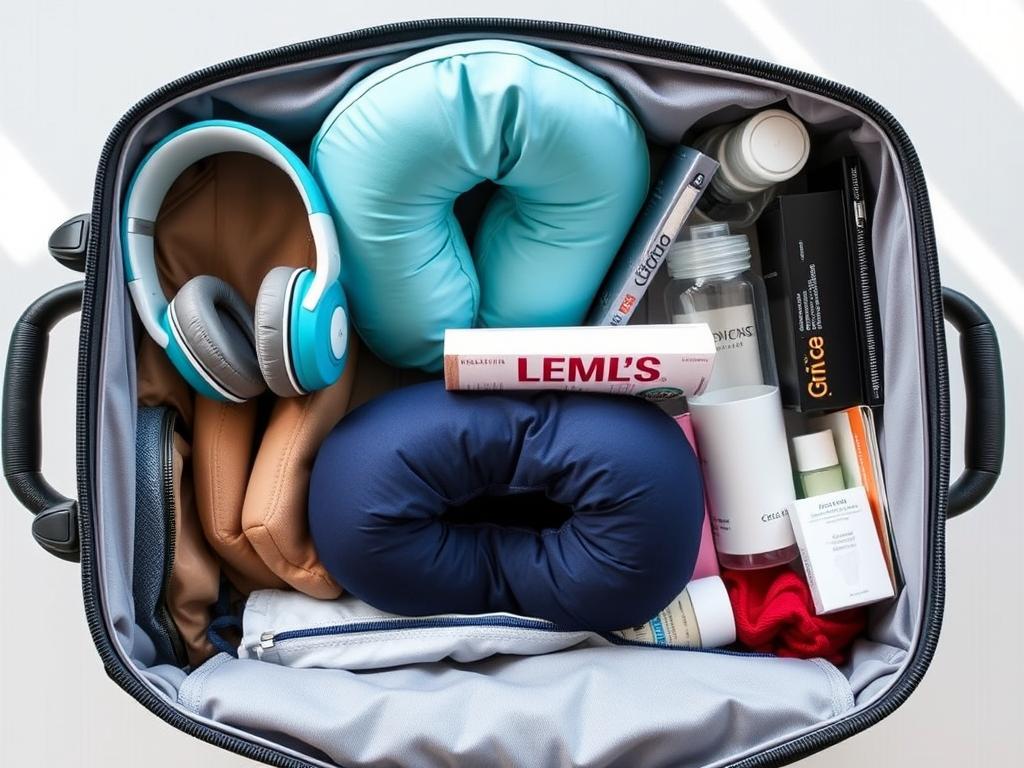
What you bring onboard can dramatically improve your comfort during long flights. Here’s what experienced travelers consider must-haves:
Comfort Essentials
- Quality travel pillow (memory foam or inflatable)
- Eye mask to block cabin light
- Noise-canceling headphones
- Compression socks to improve circulation
- Light blanket or large scarf (even if the airline provides one)
- Comfortable slip-on shoes
Health & Hydration
- Reusable water bottle (empty through security, fill after)
- Moisturizer and lip balm
- Hand sanitizer and disinfectant wipes
- Toothbrush and travel-size toothpaste
- Any necessary medications in original packaging
- Healthy snacks (nuts, dried fruit, granola bars)
Traveler’s Favorite: Bose QuietComfort Headphones
Noise-canceling technology makes a dramatic difference in your flight experience by eliminating engine noise and cabin chatter. Bose QuietComfort headphones are consistently rated as the top choice among frequent flyers for their superior noise cancellation and comfort during long flights.
Entertainment & Productivity
Even with in-flight entertainment systems, it’s wise to bring your own options. Download movies, TV shows, podcasts, or audiobooks to your devices before your flight. Many streaming services now offer offline viewing options.
Don’t forget a portable charger or power bank, as not all planes have functioning power outlets. A good book or e-reader is also essential as a backup that doesn’t require power.
Pro Tip: Pack a small toiletry kit in your carry-on with essentials like a toothbrush, toothpaste, deodorant, and face wipes. Freshening up mid-flight or before landing can make a world of difference in how you feel.
In-Flight Survival Strategies: Staying Comfortable for Hours
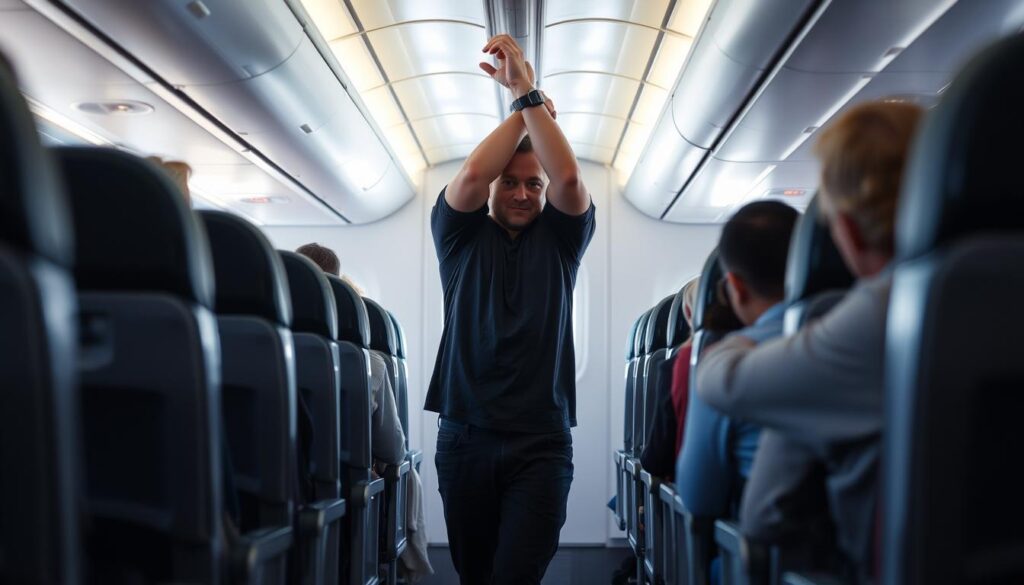
Move Regularly to Prevent Stiffness
Sitting in one position for hours can lead to stiffness and increase your risk of deep vein thrombosis (DVT). Set a timer to remind yourself to move every 1-2 hours. Simple exercises you can do in your seat include:
- Ankle circles and foot flexes
- Shoulder rolls and neck stretches
- Gentle twists while seated
- Standing and walking the aisle when the seatbelt sign is off
Stay Hydrated Throughout the Flight
The low humidity in airplane cabins (typically around 10-20%) can quickly lead to dehydration. Aim to drink 8 ounces of water for every hour you’re in the air. Bring a reusable water bottle that flight attendants can refill throughout the journey.
Limit alcohol and caffeine consumption as they can contribute to dehydration and disrupt your sleep patterns. If you do indulge, balance each alcoholic or caffeinated beverage with an extra glass of water.
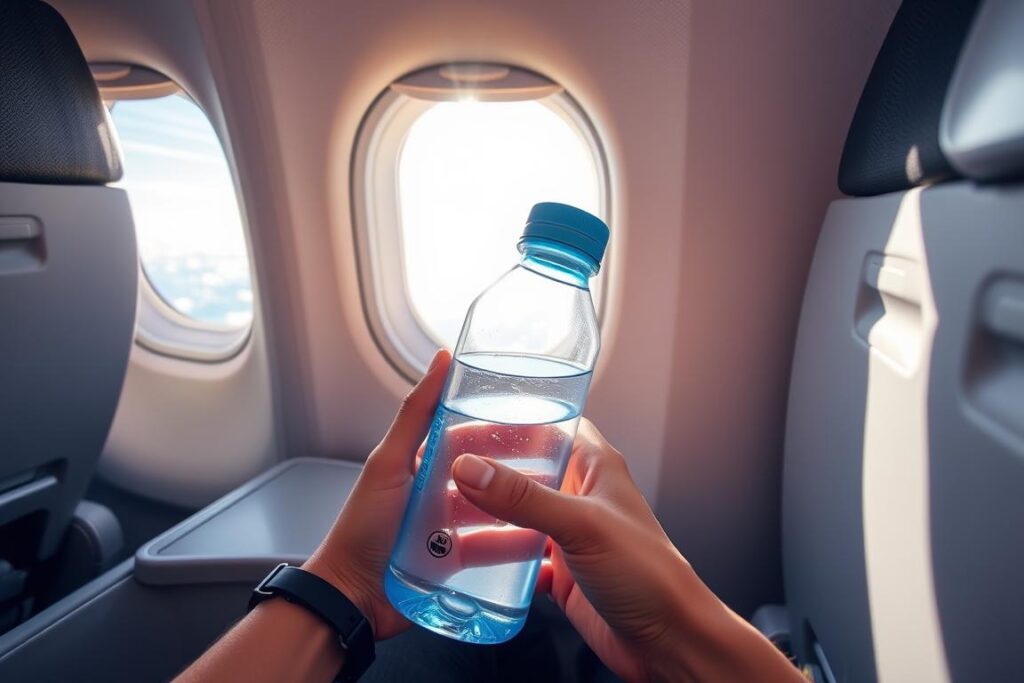
Manage Jet Lag Proactively
Start adjusting to your destination’s time zone before you even board the plane. If you’re flying east, try going to bed and waking up earlier for a few days before your flight. If heading west, do the opposite.
Once on board, set your watch to your destination’s time zone and try to sleep when it would be nighttime there. This helps your body begin the adjustment process during the flight.
Flight Attendant Secret: Many experienced cabin crew members use melatonin to help regulate their sleep cycles when crossing multiple time zones. Always consult with your doctor before trying any sleep supplements.
How to Sleep Better on Long Flights
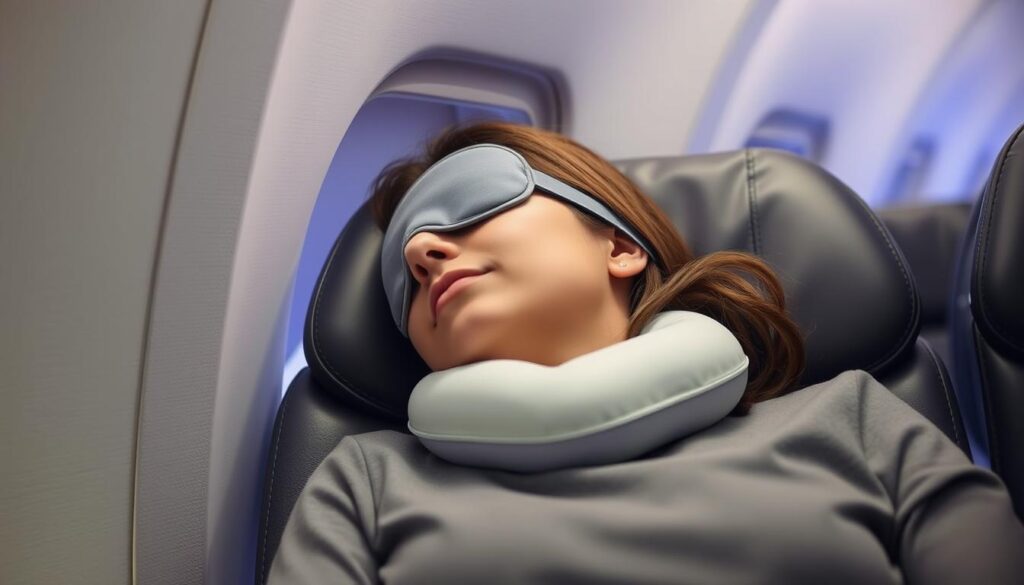
Quality sleep can transform your long-haul experience, but the airplane environment presents unique challenges. Here’s how to maximize your chances of getting restful sleep:
Create Your Sleep Environment
Even in economy class, you can create a more sleep-friendly space:
- Use an eye mask to block out light
- Wear noise-canceling headphones or earplugs
- Secure your head with a quality travel pillow
- Recline your seat if possible (check behind you first)
- Use the provided blanket or bring your own
- Loosen your seatbelt and wear it over your blanket so flight attendants can see it
Traveler’s Choice: Cabeau Evolution S3 Travel Pillow
The right travel pillow can make all the difference between arriving refreshed or exhausted. The Cabeau Evolution S3 consistently ranks as a top choice among frequent flyers for its superior neck support and comfort features designed specifically for sleeping upright.
Best Sleeping Positions
Finding a comfortable position in a confined airplane seat is challenging but not impossible:
- Window seat sleepers: Lean against the window with your pillow for support
- Middle or aisle seat: Use your travel pillow to support your neck and prevent your head from dropping forward
- Crossed arms technique: Place your tray table down, put a pillow or folded jacket on top, and rest your crossed arms and head on it
Timing Your Sleep
Align your sleep schedule with your destination’s time zone. If it’s nighttime at your destination, try to sleep on the plane. If it’s daytime, try to stay awake. This strategy helps minimize jet lag upon arrival.
If you’re on a very long flight (12+ hours), it’s reasonable to have multiple sleep sessions. Just make sure your final wake-up time is aligned with morning at your destination.
What to Wear for Maximum Comfort on Long Flights

Your clothing choices can significantly impact your comfort during long flights. The key is to dress in layers that can be adjusted as cabin temperatures change.
The Ideal Long-Flight Outfit
- Base layer: Breathable, moisture-wicking t-shirt or long-sleeve shirt
- Mid layer: Light sweater or zip-up hoodie that’s easy to remove
- Bottom layer: Stretchy, non-restrictive pants (joggers, leggings, or loose-fitting jeans)
- Footwear: Slip-on shoes that are easy to remove for security and comfort
- Accessories: Compression socks, warm socks to change into during flight
“We do it ourselves. I think most people do it themselves. It’s the right thing to do if you’re going on a long-haul flight.”
Fabric Choices Matter
Opt for natural, breathable fabrics like cotton, bamboo, or technical fabrics designed for comfort. Avoid synthetic materials that don’t breathe well, as they can make you feel sweaty or uncomfortable during a long flight.
Many travel clothing brands now offer specialized items designed specifically for long flights, featuring wrinkle-resistant fabrics, hidden pockets, and stretch materials for maximum comfort.
Recommended: Athleta Travel Line
Athleta’s travel clothing line offers the perfect balance of comfort and style for long flights. Their joggers and layering pieces are specifically designed to keep you comfortable during extended travel while still looking put-together upon arrival.
Health and Wellness Hacks for Long Flights
Combat Dry Cabin Air
The low humidity in airplane cabins can wreak havoc on your skin and respiratory system. Beyond staying hydrated, consider these strategies:
- Apply a hydrating face mask or moisturizer during the flight
- Use a nasal spray to keep nasal passages moist
- Apply lip balm regularly
- Consider a small facial mist spray for refreshing hydration
Prevent Swelling and Circulation Issues
Prolonged sitting can cause fluid retention and swelling, particularly in the legs and feet. To combat this:
- Wear compression socks during the flight
- Remove your shoes (but have clean socks on)
- Elevate your feet when possible by using your carry-on under the seat in front
- Avoid crossing your legs for extended periods
- Perform seated ankle exercises every 30 minutes
Pro Tip: Bring a tennis ball or massage ball to roll under your feet or against your back during the flight. This improves circulation and relieves muscle tension from sitting for extended periods.
Immune System Support
Airplanes can be breeding grounds for germs. Support your immune system with these strategies:
- Wipe down your seat area, tray table, and armrests with disinfectant wipes
- Use hand sanitizer regularly, especially before eating
- Consider taking immune-supporting supplements before and during travel (consult your doctor first)
- Stay hydrated to help your body’s natural defense mechanisms
Keeping Yourself Entertained During Long Flights
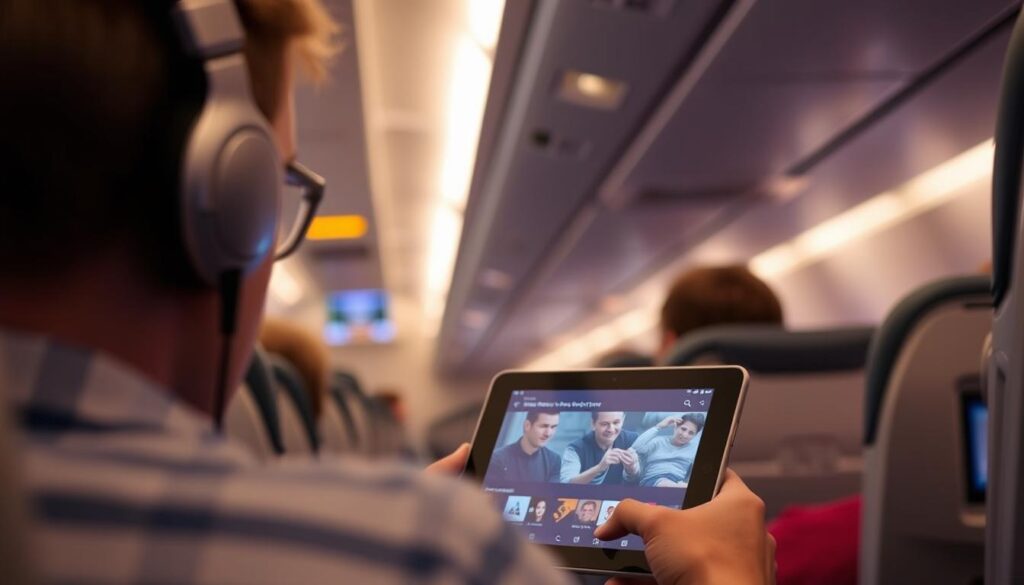
Boredom can make a long flight feel even longer. Having multiple entertainment options is key to making the time pass more quickly.
Digital Entertainment Options
- Download movies, TV shows, or documentaries to your tablet or laptop
- Prepare a playlist of podcasts or audiobooks
- Download games that don’t require internet connection
- Bring an e-reader loaded with several books
Non-Digital Alternatives
Having non-electronic entertainment options is crucial for when you need a screen break or if your devices run out of battery:
- Physical books or magazines
- Crossword puzzles, sudoku, or adult coloring books
- Journal for writing or sketching
- Small card games if traveling with companions
“Most people self-cater flights now when it comes to entertainment. There’s only so much we can do on the aircraft to kick it back to life if it starts to play up.”
Productive Use of Flight Time
Long flights can also be an opportunity to accomplish tasks without the usual distractions:
- Learn a new language using offline learning apps
- Plan your itinerary for your destination
- Catch up on work that doesn’t require internet
- Practice meditation or mindfulness exercises
Power Up: Anker PowerCore Portable Charger
Don’t let a dead battery cut your entertainment short. The Anker PowerCore provides multiple full charges for your devices, ensuring you stay entertained throughout even the longest flights, especially when seat power isn’t available.
Making the Most of Layovers
Layovers are an inevitable part of many long-haul journeys. With the right approach, they can be an opportunity to rest and refresh rather than an additional travel burden.
Short Layovers (1-3 hours)
For brief connections, focus on essential needs:
- Locate your next gate immediately
- Use restrooms to freshen up
- Stretch your legs by walking around the terminal
- Find a healthy meal or snack
- Refill your water bottle
Medium Layovers (4-7 hours)
With more time to spare, consider these options:
- Access an airport lounge (through membership, credit card perks, or day passes)
- Take a shower if facilities are available
- Find a quiet corner to nap
- Explore the airport’s amenities (shops, restaurants, art exhibits)
- Use airport Wi-Fi to connect with family or handle online tasks
Airport Lounge Access: Many credit cards offer complimentary Priority Pass membership or airport lounge access. Check your card benefits before traveling to see if you qualify for this valuable perk.
Long Layovers (8+ hours)
Extended layovers offer opportunities for more substantial rest or exploration:
- Book an airport hotel room for proper sleep (some airports have in-terminal hotels)
- Consider leaving the airport to explore the city if time permits
- Look for day-use hotel options through services like Dayuse
- Research if the airline offers free city tours for long layovers (Singapore, Istanbul, and Doha airports sometimes offer these)
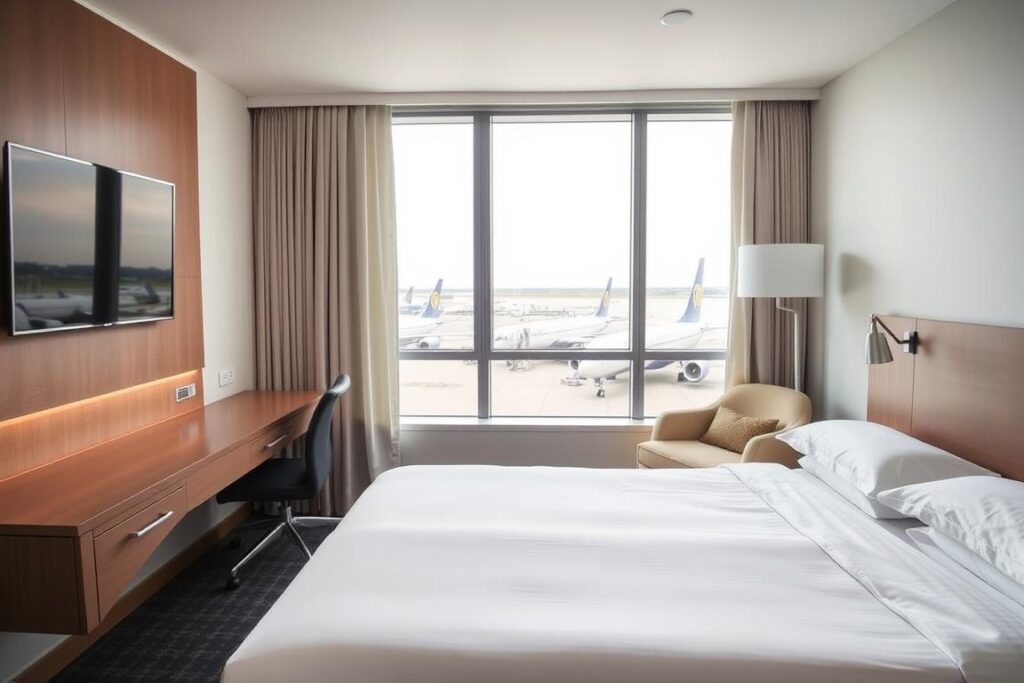
Arrival Recovery: Bouncing Back After a Long Flight

How you spend the first few hours after landing can significantly impact your recovery from a long flight and set the tone for your entire trip.
Immediate Post-Flight Recovery
- Hydrate extensively upon arrival
- Take a shower as soon as possible
- Change into fresh clothes
- Stretch or do light exercise to improve circulation
- Get some natural sunlight to help reset your circadian rhythm
Adapting to the New Time Zone
The key to minimizing jet lag is to adapt to local time as quickly as possible:
- If you arrive in the morning or afternoon, try to stay awake until a normal local bedtime
- If you arrive at night, it’s okay to go to sleep, but set an alarm for a reasonable local wake-up time
- Eat meals according to local mealtimes, even if you’re not hungry
- Avoid napping longer than 30 minutes during the day
Caution: Avoid making critical decisions or driving if you’re severely jet-lagged. Sleep deprivation can impair judgment and reaction times similar to alcohol consumption.
Recovery Nutrition
What you eat after arrival can help your body recover more quickly:
- Focus on hydrating foods like fruits and vegetables
- Choose protein-rich meals to help with recovery
- Limit alcohol for the first 24 hours after arrival
- Consider foods rich in melatonin (cherries, nuts) in the evening to help with sleep
Special Situations: Traveling with Children, Anxiety, and Health Conditions
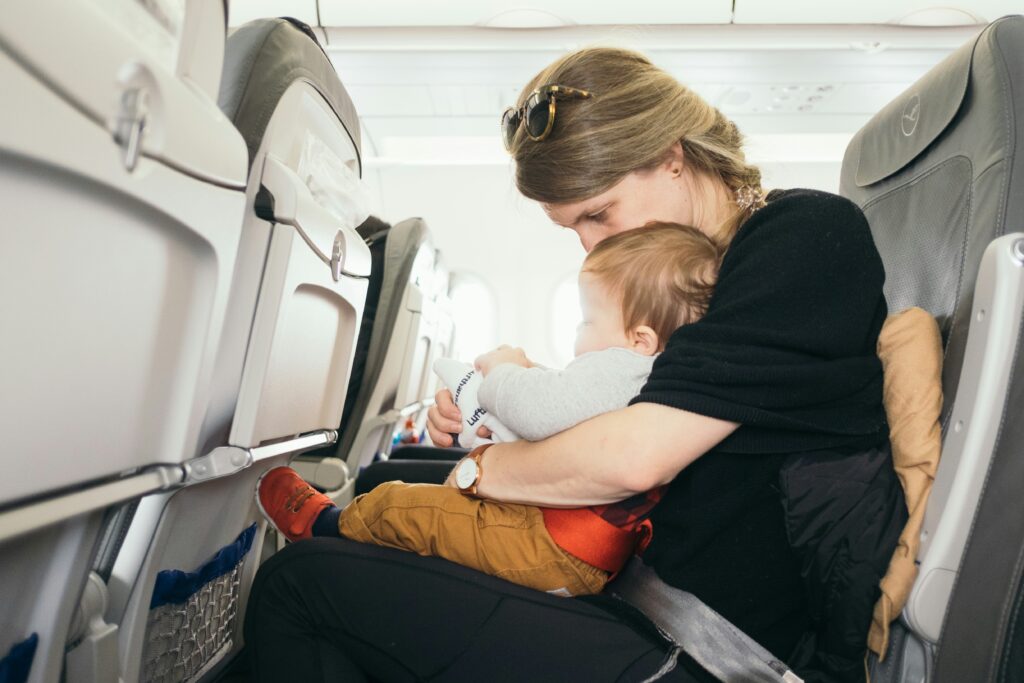
Surviving Long Flights with Children
Traveling with kids requires extra preparation but can still be manageable:
- Pack plenty of new or novel activities to maintain interest
- Bring favorite comfort items (blanket, stuffed animal)
- Pack more snacks than you think you’ll need
- Consider noise-canceling headphones sized for children
- Download child-appropriate entertainment before the flight
- Schedule flights around their normal sleep times when possible
“If you’re tense, your child will be tense, it’s as simple as that. If you’re stressed, and you’re feeling anxious, your child will be anxious.”
Managing Flight Anxiety
For those who experience anxiety during flights:
- Practice deep breathing techniques or meditation
- Inform flight attendants about your anxiety
- Choose an aisle seat if you’re prone to claustrophobia
- Bring comforting items like a favorite scarf or essential oils
- Consider speaking with your doctor about anti-anxiety options
Flying with Health Conditions
If you have existing health conditions, take these additional precautions:
- Consult your doctor before long flights
- Carry all necessary medications in your carry-on
- Bring a doctor’s note for any liquid medications exceeding security limits
- Consider medical alert identification if appropriate
- Research medical facilities at your destination and layover locations
- Check if your travel insurance covers pre-existing conditions
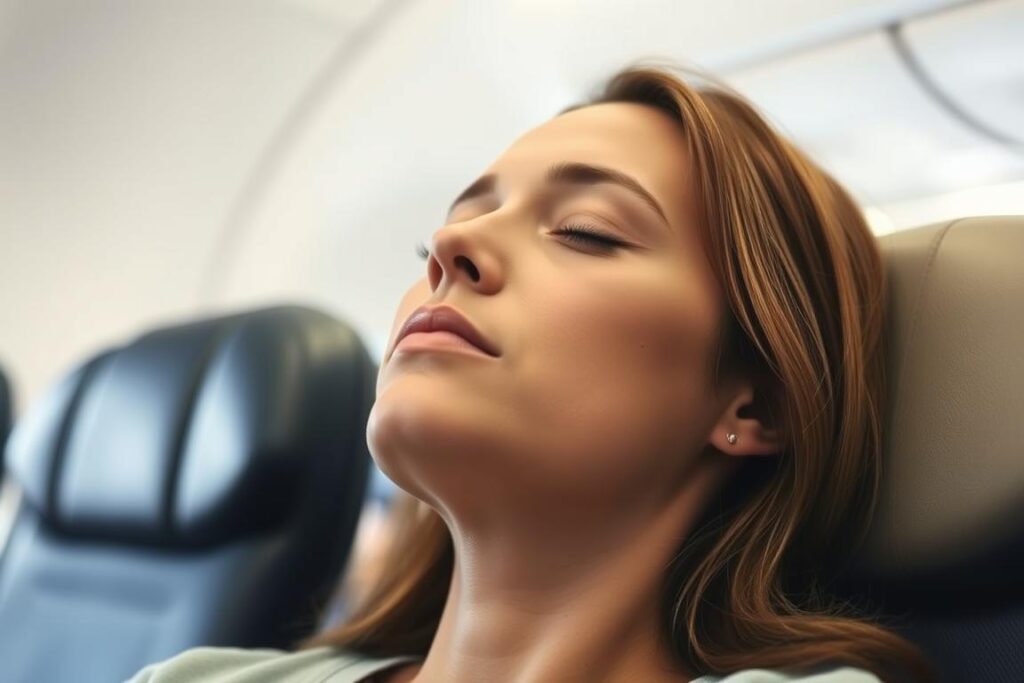
Frequently Asked Questions About Surviving Long Flights
How do you stay sane on a 15+ hour flight?
The key to maintaining your sanity on ultra-long flights is variety. Break the journey into manageable segments with different activities: watch a movie, read for an hour, try to sleep, have a meal, do some stretches, etc. Having multiple entertainment options and alternating between them prevents boredom. Also, set mini-milestones throughout the flight rather than focusing on the total duration.
Is it okay to wear contact lenses on long flights?
It’s generally not recommended to wear contact lenses during long flights. The low humidity in airplane cabins can cause your eyes to become dry and uncomfortable, potentially leading to irritation or infections. If you must wear contacts, use preservative-free rewetting drops frequently, consider wearing glasses for part of the flight, and never sleep with contacts in. Many optometrists recommend switching to glasses for flights longer than 4 hours.
How do you avoid jet lag on long international flights?
While you can’t completely avoid jet lag on long flights crossing multiple time zones, you can minimize its effects by: 1) Gradually adjusting your sleep schedule a few days before departure, 2) Setting your watch to your destination’s time zone as soon as you board, 3) Sleeping on the plane when it’s nighttime at your destination, 4) Staying hydrated and avoiding excessive alcohol, 5) Getting natural sunlight upon arrival, and 6) Forcing yourself to stay awake until a normal bedtime at your destination.
Should you take sleeping pills for long flights?
Prescription sleeping medications should be used with caution on flights. The confined space and prolonged sitting position can increase risks of side effects. If you’re considering sleep aids, discuss with your doctor first and try them at home before your trip. Many travelers find that natural alternatives like melatonin (taken at the appropriate time for your destination) can be effective with fewer side effects. Never combine sleeping pills with alcohol.
How early should you arrive at the airport for international long-haul flights?
For international long-haul flights, arrive at least 3 hours before departure. This provides adequate time for check-in, security screening, passport control, and boarding. During peak travel seasons or at particularly busy airports, consider adding an extra 30-60 minutes. If you’re checking bags, traveling with children, or have special requirements, additional time may be necessary.
Final Thoughts on Surviving Long Flights
Long flights don’t have to be an ordeal. With proper preparation, the right gear, and smart in-flight strategies, you can arrive at your destination feeling relatively refreshed and ready to enjoy your trip.
Remember that everyone’s needs are different – what works for one traveler might not work for another. Experiment with these strategies to find your personal formula for comfortable long-haul travel.
Safe travels, and may your next long flight be your most comfortable yet!

Eduard Kingly is a travel and lifestyle content creator with a focus on personal development and education. He combines firsthand travel experiences with research-driven insights to guide readers in discovering new places, building better habits, and pursuing meaningful learning.

